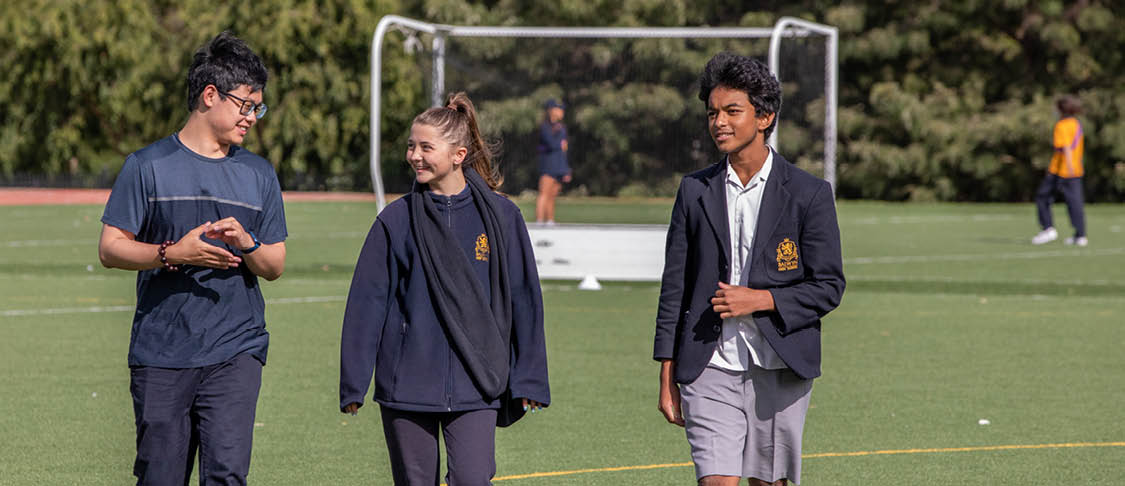The Victorian school system has a great reputation, with high quality teachers, a diverse curriculum, students from many different backgrounds and learning spaces that bring out the best in everyone.
The information below will give you a good overview of education in Victoria, Australia, whether in regional schools or schools in Melbourne. School systems vary, so this may be different from the system in your country.
 Age
Age
Education in Victoria, Australia is compulsory for children aged from 6 to 17 years. In the Australian school system, students attend school for a total of 13 years.
Primary school students are aged between 5 and 12 years old. Classes are divided into Prep and Years 1 to 6.
Secondary school students are aged between 12 and 20 years old. Classes are divided into Years 7 to 12.
School types
The Australian school system has a range of schools including:
Most Victorian government schools are co-educational but there are also some single-gender schools.
Class sizes and ratios

Typical school day
School takes place five days per week, from around 8:30am to 3:30pm, Monday to Friday. On a
typical school day, students tend to move from classroom to classroom rather than staying in one room, and even moving outside the classroom with our
interactive teaching methods.
The school year
There are 2 semesters broken up into 4 terms in the Victorian school year. School usually starts in late January or early February and ends mid-December. There are short holidays between terms and a long summer holiday in December and January.
Term dates for most international students in the upcoming Victorian school years are:
|
2024 |
Australian season |
Term starts | Term ends |
Number of
weeks
|
|---|
Semester 1
| | | | |
| Term 1 | Summer / Autumn
| 29 January | 28 March
| 9
|
| Term 2 | Autumn / Winter | 15 April | 28 June | 11
|
Semester 2
| | | | |
| Term 3 | Winter / Spring | 15 July | 20 September | 10
|
| Term 4 | Spring / Summer | 7 October | 20 December
| 11
|
2025
| Australian season | Term starts
| Term ends
| Number of
weeks
|
|---|
Semester 1
|
|
| | |
| Term 1 | Summer / Autumn | 28 January | 4 April
| 10
|
| Term 2 | Autumn / Winter | 22 April | 4 July
| 11
|
Semester 2
| | | |
|
| Term 3 | Winter / Spring | 21 July | 19 September | 9
|
| Term 4 | Spring / Summer | 6 October |
19 December | 11
|
Short-term study abroad students have different term dates depending on the year level studied. For study abroad term dates, see:
Study Abroad Program.
Curriculum and school programs
The school
curriculum in Victoria depends on the student year level:
- Victorian Curriculum F–10 – incorporates the Australian Curriculum, reflecting Victorian priorities and standards.
- Victorian Certificate of Education for Years 11 and 12.
All schools also offer extracurricular programs with many options and experiences.
How we teach our students
Our
teaching approach focuses on the student and leads to better academic results and a happier time at school.
All Victorian teachers are university qualified. As part of their degree, they have hands-on experience in schools through a supervised practicum placement program, also known as ‘teaching rounds’.
You’ll usually talk to your teacher using their title and surname: Ms, Mrs or Mr X. Teachers usually talk to students by their first name.
How we manage our schools
The school principal is the leader and manager of the school and its education program. Each school has a council with parent, community and staff representatives that help to make sure the school is operating at its best.
Learning spaces
Excellent facilities and
learning spaces are a key feature of Victorian government schools. All schools have purpose-built learning, sports and recreation centres.
Access to computers
Across the state of Victoria, the& average student to computer ratio is approximately 1 to 1. Schools will either lease laptops to students for the duration of their studies, or students can bring their own devices.
Uniforms
Most of our schools have a set uniform that you have to wear. There are often winter and summer uniforms with clothes in the school colours.
Students have the choice of wearing:
- trousers, shorts or skirts
- a shirt and blazer or jumper (pullover).
Students can wear clothing particular to their religion or culture in Victorian government schools. For example, Muslim female students can wear a hijab.
Language classes
Languages (other than English) classes are available from Prep to Year 12. Language classes are taught by qualified language teachers and usually total 150 minutes per week.
Languages are taught in Victorian government primary schools and in secondary schools. Over 40 languages are taught through the
Victorian School of Languages (VSL).
Student language background
Almost 25 per cent of students at our schools are from language backgrounds other than English, which is why we have such an extensive
EAL program and many of our schools are staffed with Multicultural Education Aides.
Each school is different. Some have students mainly from Anglo-Saxon backgrounds, while others have a mix of many nationalities in their classes.
CRICOS Provider Name and Code: Department of Education, 00861K.
CRICOS Course Names and Codes: Primary (Prep to Year 6), 019047G; Secondary (7-12), 019048F; Victorian College of the Arts Secondary Course (7-12), 028651A.




